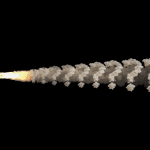Why it could (but shouldn’t) be the end of the arms control era
By Lawrence J. Korb | October 23, 2018
 President Ronald Reagan and Soviet General Secretary Gorbachev signing the INF Treaty in the East Room of the White House on December 8, 1987. Credit: Ronald Reagan Presidential Library
President Ronald Reagan and Soviet General Secretary Gorbachev signing the INF Treaty in the East Room of the White House on December 8, 1987. Credit: Ronald Reagan Presidential Library
Even before President Trump reversed his position and announced (at a campaign rally for Republican congressional candidates in Nevada, no less) that he was pulling the United States from the Intermediate-Range Nuclear Forces Agreement (INF), the era of significant nuclear arms control agreements between the United States and Russia was in danger of ending. Such a development must be forestalled at all costs, because arms control efforts have over the last 50 years shown themselves to be remarkably effective.
From the 1963 Limited Test Ban Treaty, which banned nuclear testing in the atmosphere, to the 2011 New START Agreement, which limited the two countries to no more than 1,550 deployed nuclear weapons on no more than 700 deployed delivery vehicles, the two major nuclear powers have concluded dozens of bilateral agreements and supported several multilateral arms pacts.
As a result, the total number of nuclear weapons possessed by the United States and the Soviet Union/Russia has dropped from about 60,000 in 1972 to approximately 13,000 today. Moreover, the agreements have provided for extremely intrusive inspections that ensure that both parties are living up to their terms.
These US-Russia arms control treaties have been concluded by both Democratic and Republican presidents, and Soviet Communist Party leaders and Russian presidents. In addition to the formal arms control treaties, the two major nuclear powers have also entered a number of executive agreements designed to avoid provocative actions or mistakes that could lead to a nuclear exchange. These included establishing a communications hotline in 1963, in the wake of the Cuban Missile Crisis, and entering the Incidents at Sea Agreement in 1972.
In addition to the bilateral agreements, the United Nations has brokered a number of treaties with the majority of the global community to limit the spread and testing of nuclear weapons, including the Nuclear Non-Proliferation Treaty (NPT) of 1968, the Comprehensive Test Ban Treaty (CTBT) of 1996, and the Treaty Prohibiting the Possession of Nuclear Weapons of 2017. Unfortunately these global treaties have not been ratified by all of the world’s leading powers. For example, the US Senate failed to ratify the CTBT, and none of the nine nations that currently possess nuclear weapons ratified the 2017 nuclear ban treaty. However, these multilateral agreements did set a global norm: Nuclear weapons should never be used again, and non-nuclear states should not develop nuclear weapons. And the international community has put significant sanctions in place against countries, like Iran and North Korea, that have violated the NPT.
These bilateral and multilateral treaties have improved global security in a number of important ways. They have reduced the number of strategic nuclear weapons possessed by the United States and Russia and, in the case of the INF, eliminated an entire class of weapons. Also, these agreements have motivated many countries not to develop nuclear weapons in the first place, and several nations, including South Africa and Iran, were persuaded to actually give up or stop producing these weapons.
There are at least five reasons this very productive and successful era of arms control may now be ending:
- The last remaining treaty limiting US and Russian strategic offensive nuclear weapons expires in 2021, and President Trump has so far refused Russian President Putin’s offer to extend it another five years, which can be done without approval by the US Senate or the Russian Duma. This treaty not only limits the number of nuclear weapons each side can deploy, but also allows each side to inspect the other’s nuclear facilities up to 18 times a year.
- To get enough support from Republican members for a two-thirds vote in the Senate necessary to ratify the New START Treaty in 2011, President Obama had to agree to undertake a significant modernization program for all three legs of the US nuclear arsenal. This program will dramatically increase the targeting and kill capability of US strategic nuclear weapons and also forestall any effort to reduce the size of the US nuclear arsenal, committing the United States to maintain at least the current, New START numbers of warheads and platforms for the foreseeable future. President Trump has compounded the problem by not only endorsing the nuclear modernization program, but also by proposing, in his 2017 Nuclear Posture Review, to add funds to develop two new tactical nuclear weapons—a move that could actually lower the threshold for using nuclear weapons.
- In 2002, President George W. Bush unilaterally withdrew the United States from the Anti-Ballistic Missile Treaty of 1972, which limited the United States and the Soviet Union to deploying no more than a single ballistic missile defense system. President Bush claimed that this step was necessary for the Unitd States to deal with missile threats from the “axis of evil” countries—Iran, Iraq, and North Korea. Bush proposed the deployment of ballistic missile defenses in Poland and the Czech Republic—installations that he claimed were necessary to protect Europe from Iranian nuclear missiles. Although the Obama administration modified the Bush plan somewhat, placing Aegis Ashore missile defense systems in Poland and Romania, these moves did nothing to assuage the concerns of Russian leaders, who believe the systems can be modified to become offensive weapons.
- The Trump administration has unilaterally withdrawn from the Iran nuclear agreement, even though the Iranians were abiding by its terms. The Russians were a signatory to the Iran deal, and the United States’ unilateral abrogation of it casts a pall over any future moves toward either bilateral or multilateral nuclear agreements.
- Finally, as Trump noted last week, the Russians have consistently violated the INF. That treaty—which prohibits the United States and Russia from developing and deploying missiles that could carry a nuclear weapon to a range of between 500 and 5,500 kilometers—has been extraordinarily successful, reducing nuclear tensions and deployments in Europe over the course of decades. Since its enactment in the 1980s, in fact, the pact has resulted in the destruction of 2,700 missiles. But in recent years, the Russians have also embarked on their own strategic nuclear modernization program and developed a ground-launched cruise missile that appears to clearly violate the pact, which now seems in danger of being renounced by both sides.
To reverse this dangerous trend toward arms control collapse, the United States should immediately take Putin up on his offer to extend New START for five more years and begin work on a follow-on treaty that will reduce the number of deployed nuclear weapons to no more than 1,000. This process of building the next agreement when an existing arms reduction agreement nears its expiration date has been followed successfully in the past; there is no reason it cannot work now. In addition, the United States should allow the Russians to inspect the proposed missile defense sites in Poland and Romania to demonstrate that they cannot be used for offensive purposes. In return, rather than withdraw from the INF Treaty, the United States should ask to inspect the Russian 9M729 (SSC-8), which is the missile the United States claims violates the INF, and seek to negotiate a solution, if the missile is indeed found to violate the treaty.
Our NATO allies say the INF is crucial to Euro-Atlantic security. Preserving it will help stabilize the entirety of the arms control regime. At that point, the United States could take further reasonable and practical steps to make sure the arms control era continues well into the future. Among these are the formal adoption of a no first use policy for nuclear weapons, something Putin recently embraced and something the United States has refused to do since the Cold War, when the Soviets had superior conventional forces, a situation that no longer exists. And ultimately, both the United States and Russia could seek to make China a part of a new, enlarged INF Treaty that would curb destabilizing cruise and ballistic missile programs.
Together, we make the world safer.
The Bulletin elevates expert voices above the noise. But as an independent nonprofit organization, our operations depend on the support of readers like you. Help us continue to deliver quality journalism that holds leaders accountable. Your support of our work at any level is important. In return, we promise our coverage will be understandable, influential, vigilant, solution-oriented, and fair-minded. Together we can make a difference.
Keywords: INF, New START, arms control
Topics: Analysis, Nuclear Risk, Nuclear Weapons, The INF Treaty and the Future of Arms Control
Share: [addthis tool="addthis_inline_share_toolbox"]














